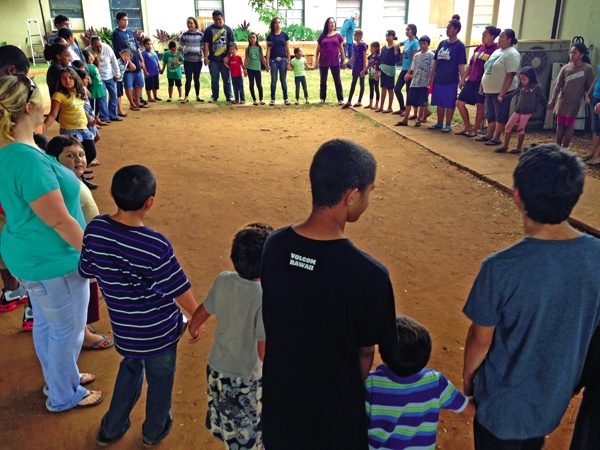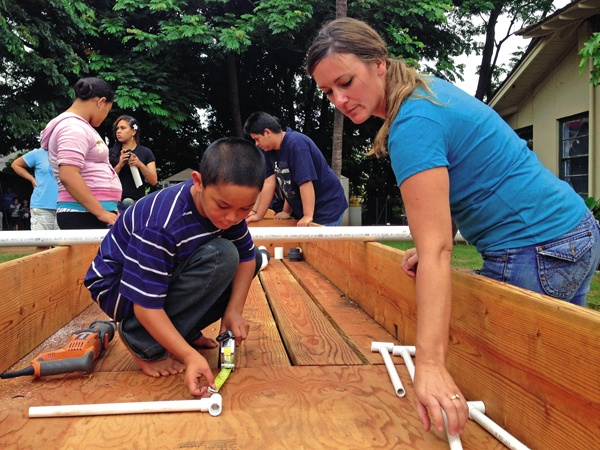KEKAHA — A hands-on project in a charter school on Kauai’s Westside may not feed the world, but it is aiming to grow an abundance of food by the end of the school year. And like all good class assignments,
KEKAHA — A hands-on project in a charter school on Kauai’s Westside may not feed the world, but it is aiming to grow an abundance of food by the end of the school year.
And like all good class assignments, the students are learning about a handful of subjects — even cultural practices and a few professional skills.
How’s that for homework?
“We want to be modern Hawaiians doing what ancient Hawaiians did,” said Steven Sullivan, a math teacher at Kula Aupuni Niihau A Kahelelani Aloha in Kekaha.
The aquaponics project, which combines raising fish with cultivating plants, has everyone involved.
Since joining the school this semester, science teacher Stefanie Camp spearheaded the effort whose goal is to have at least one good harvest by the end of the school year.
“Everything is going to be organic, there are no chemicals involved,” Camp said of the project started completely from scratch.
The charter school first opened in 1999, with classes taught at Kekaha Park, and two years later it became licensed. In 2004, the school moved to its current location at a commercial complex on Kekaha Road.
“We had nothing and we have come a long way,” principal Hedy Sullivan said.
Originally, the vast majority of students were children of Niihau natives living on Kauai, but that is not a requirement to enroll, and today, nearly half of the school’s 61 students are from Niihau, she said.
“Our school is our ohana,” Sullivan said.
Since joining the school’s ohana, Camp wanted to bring something new. After all, she came from a school on the Big Island that promoted several sustainability projects, including an aquaponics program. But she said this is the first time she initiated a project of this magnitude.
So far, it has been a ‘huge learning process’ for the children, who work on the project every Friday alongside teachers and sometimes parents. Seeing the children learn as the project moves along is what’s amazing for her.
By building the entire project from scratch, the children are learning engineering skills, carpentry, math, science and even literature, since they have to write about it, Camp said. And they’re also learning about responsibility and real life experiences, she said.
But there’s something there for the teachers, too.
“It’s a huge gratification to show the kids that as an adult, you still learn,” Camp said. “It’s OK to make mistakes; we’re going to learn together and grow.”
As the construction of the water beds advances, seedlings of different varieties of vegetables are already sprouting on starters filled with cocopeat and vermiculite. There’s absolutely no dirt involved there. Butter crunch lettuce, chives, cabbage, bok choy and parsley are a few of the vegetables already sprouting.
The system will have two large plastic fish tanks with golden tilapia — which will also be eaten. An electric pump takes the water from the tanks to the far end of two wood beds lined with plastic.
Combined, the wood beds measure 4 feet wide by 30 feet long. The vegetables will be placed on small holes carved in a foam board resting on top of the water beds, to allow the roots to dangle in the water. As gravity brings the water back to the fish tanks, the waste from the tilapia feeds the vegetables.
The children’s excitement about the project is easy to spot. They want to help as much as possible.
Fifth grader Josh Lagmay was serious about measuring the patterns in which the PVC pipes will be laid out inside the beds. A week before, he was the one who measured the level of the wood beds.
Keanu Yadao was happy to connect pipes, while Maka Babila wanted to plant, and her twin sister, Lana Babila, wanted to connect boxes. Tita Reyes wanted it all, to connect boxes and to plant.
“Science is my favorite,” said Niihau native Megan Kelii.
She said there are no supermarkets on Niihau. She wants to learn as much as possible about growing food and bring her newly acquired knowledge back to Niihau, she said.
Steven Sullivan, who is Hedy Sullivan’s husband and part of the school since the early years, was a radar software engineer for more than a quarter of a century.
He is now a certified math teacher and self-described “charter school specialist,” in relation to the many hats he wears at the school.
And that’s OK, because pretty much everyone there is willing to wear as many hats as possible to get the school going. Hedy Sullivan is not afraid to be the boss or the school bus driver.
On Fridays, she cooks for the entire school, and often a parent steps in to donate or help.
Kaleo Stevens teaches kindergarten and first grade. January McHenry teaches second and third grade. Ivy Samolinski teaches fourth and fifth grade. Myra VanOrnum teaches English and social studies to students in sixth through 12th grades.
Teacher Lauae Kanahele is originally from Niihau. She speaks English, Hawaiian and the Niihau dialect, which Steven Sullivan said is closer to other Polynesian languages than the Hawaiian language is.
Kanahele said she wants to bring back the health practices from the Hawaiian kupuna who used to live off the land and worked for their food.
Going back to basics apparently has not hindered technology learning and has been a positive thing for this tiny school. Classrooms are loaded with the latest technology, including computers and smart screens and the walls at the principal’s office are covered in awards.
Kula Aupuni Niihau a Kahelelani Aloha is at 8317 Kekaha Rd., and can be contacted at 337-2022.
• Léo Azambuja, staff writer, can be reached at 245-0452 or lazambuja@thegardenisland.com



